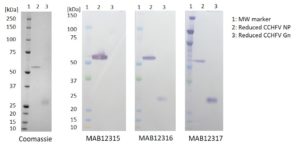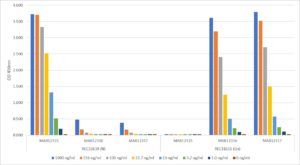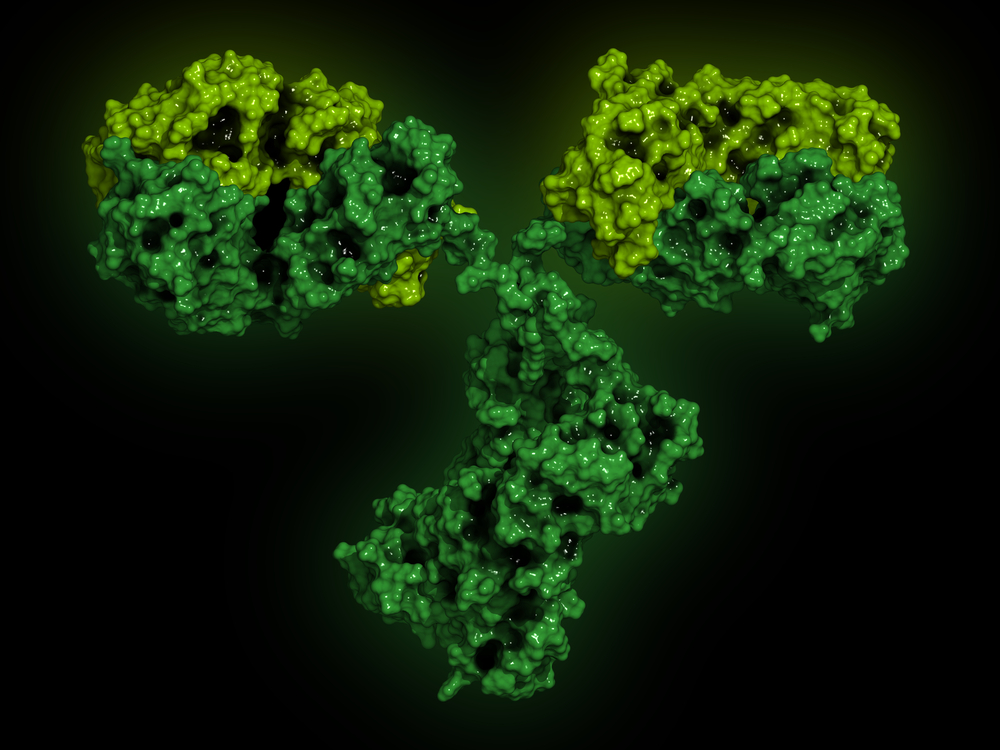
Western blot: SDS-PAGE and western blot using mouse monoclonal anti CCHFV antibodies against recombinant glycoprotein N (Gn) and Nucleoprotein (NP). MAB12317 detected both Gn and NP by western blot.

ELISA: ELISA detection showing specificity of CCHFV antibodies against CCHFV Gn and N antigens produced in mammalian cells.
MOUSE ANTI-CRIMEAN-CONGO HEMORRHAGIC FEVER VIRUS GN ANTIBODY (JE12)
Mouse anti CCHFV Gn (glycoprotein N) is a monoclonal antibody against Crimean Congo Hemorrhagic Fever Virus Glycoprotein N. The Mouse Anti CCHFV Gn antibody was raised against The Native Antigen Companys recombinant CCHF virus glycoprotein N (Gn) and Nucleoprotein (NP), expressed in mammalian HEK293 cells.
PRODUCT DETAILS – MOUSE ANTI-CRIMEAN-CONGO HEMORRHAGIC FEVER VIRUS GN ANTIBODY (JE12)
- Mouse anti Crimean Congo Hemorrhagic Fever Virus Gn (clone JE12).
- Immunogen comprised an equal mix of Crimean Congo Hemorrhagic Fever Virus Gn protein and Nucleoprotein.
- Antibody shows no cross-reactivity with CCHFV Nucleoprotein in ELISA.
- The antibody detects both Gn and NP in Western blot.
BACKGROUND
Crimean Congo hemorrhagic fever (CCHF) virus is a tick-borne enveloped single stranded RNA virus that belongs to the genus Nairovirus and a member of the Bunyaviridae family. CCHF virus causes a hemorrhagic disease in humans with up to 80% case fatality. Although the virus has only caused sporadic disease in the past, the expansion of the range of its vector, the Hyalomma tick, is causing increasing concern that case numbers will continue to rise. Since CCHF was first described in Crimea in 1944, sporadic outbreaks have occurred globally. In 2015, CCHFV was identified by the WHO as an emerging virus which is likely to cause a severe epidemic and which may present a public health emergency. Research into diagnosis of the illness, and also into vaccine development is increasing.
The CCHF virus Gn protein is a potential target for vaccine development, although efficacy has not yet been demonstrated. The CCHFV genome is circular, ambisense RNA in three parts; Small (S), Middle (M) and Large (L). The L segment encodes the RNA polymerase; the M segment encodes the envelope proteins (Gc and Gn); and the S segment encodes the nucleocapsid protein (NP). The envelope protein is initially translated as a glycoprotein precursor which is then cleaved into two smaller proteins. The CCHFV genome M segment encodes a large polyprotein (1,684 amino acids in length) containing the two major structural glycoproteins, Gn and Gc, that are post-translationally processed from precursors PreGn and PreGc by SKI-1 and SKI-1-like proteases, respectively.
REFERENCES
- Erickson,B.R. et al (2007) Virology 361:348
- Dowall, S.D. et al (2017) Vaccine 35:6015
- Dowall, S.D et al (2016) Human Vaccines and Immunotherapeutics 12:519-527
- WHO (2013) Crimean-Congo haemorrhagic fever. World Health Organisation



